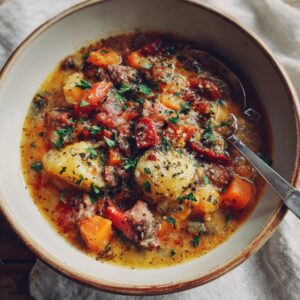Pastele Stew Recipe is a flavorful Puerto Rican comfort dish that captures the rich taste of traditional pasteles without the long hours of wrapping and steaming. Instead, all the beloved ingredients; savory meat, green bananas, plantains, root vegetables, and aromatic seasonings, are cooked together in one hearty pot. This approach gives you all the taste of the classic holiday favorite, but in a stew form that’s perfect for busy weeknights or casual family gatherings.
Originating from Puerto Rico, pasteles are typically made during the Christmas season, requiring a labor-intensive process that brings families together. The Pastele Stew Recipe takes that same essence and transforms it into an easier, more accessible dish while keeping the vibrant flavors intact. By simmering the meat with sofrito, olives, capers, and a rich achiote-based broth, you get layers of taste that pay homage to the island’s cultural and culinary heritage.
This modern twist not only saves time but also offers versatility. The Pastele Stew Recipe can be served over rice, alongside crusty bread, or even enjoyed on its own for a filling meal. Its savory aroma, colorful presentation, and deep, comforting flavor make it a crowd-pleaser for any occasion—whether it’s a festive holiday dinner or a cozy weekend at home. With every spoonful, you’ll experience a taste of Puerto Rican tradition made simple.
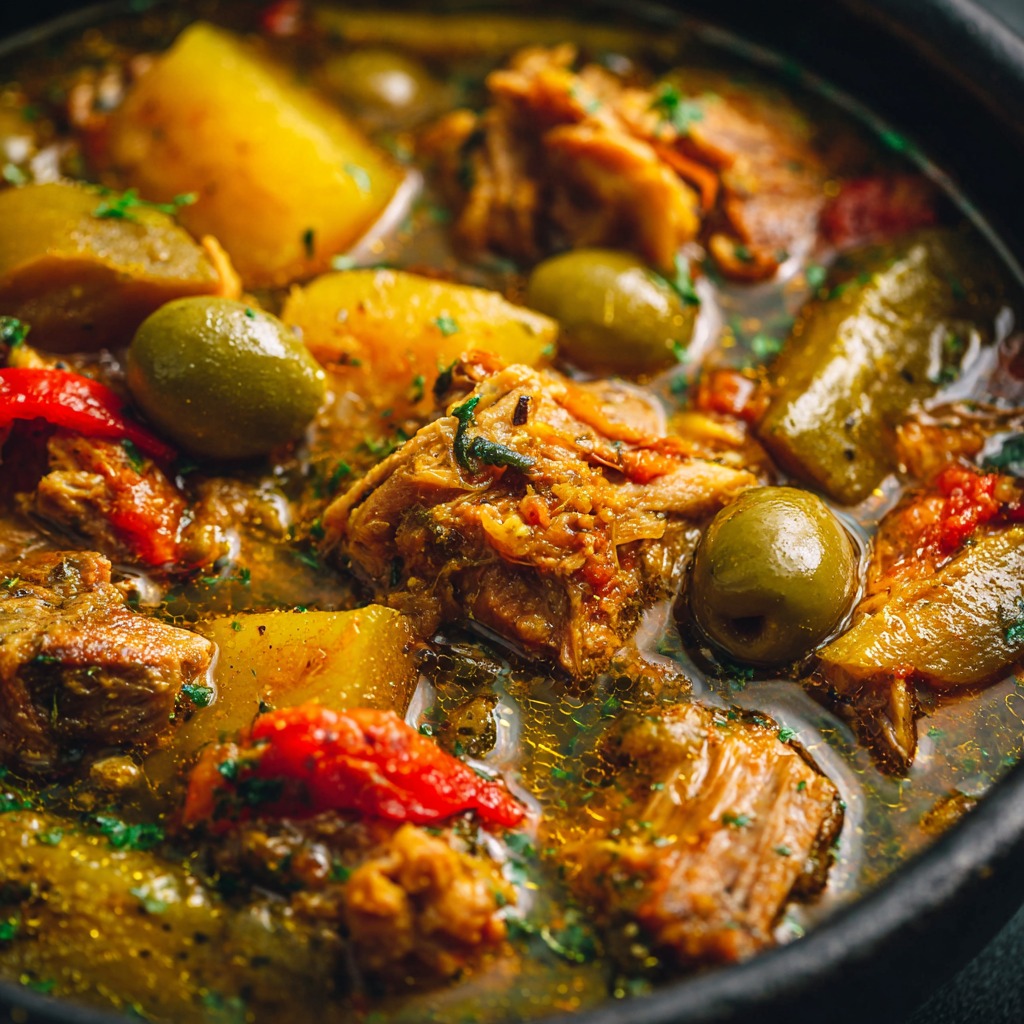
What is Pastele Stew Recipe
Pastele Stew Recipe is a Puerto Rican dish that takes all the flavors of traditional pasteles, a holiday favorite made with green bananas, plantains, and root vegetables filled with seasoned meat, and turns them into an easy-to-make stew.
Instead of wrapping each pastel in banana leaves and steaming them (which can be time-consuming), this recipe combines the grated vegetable mixture, seasoned meat, sofrito, olives, and a flavorful broth into one pot. The result is a rich, hearty stew with the same taste and aroma as pasteles but ready in a fraction of the time.
It’s especially popular for family dinners, potlucks, and holiday gatherings, as it offers the warmth and tradition of Puerto Rican cuisine while being much simpler to prepare and serve.
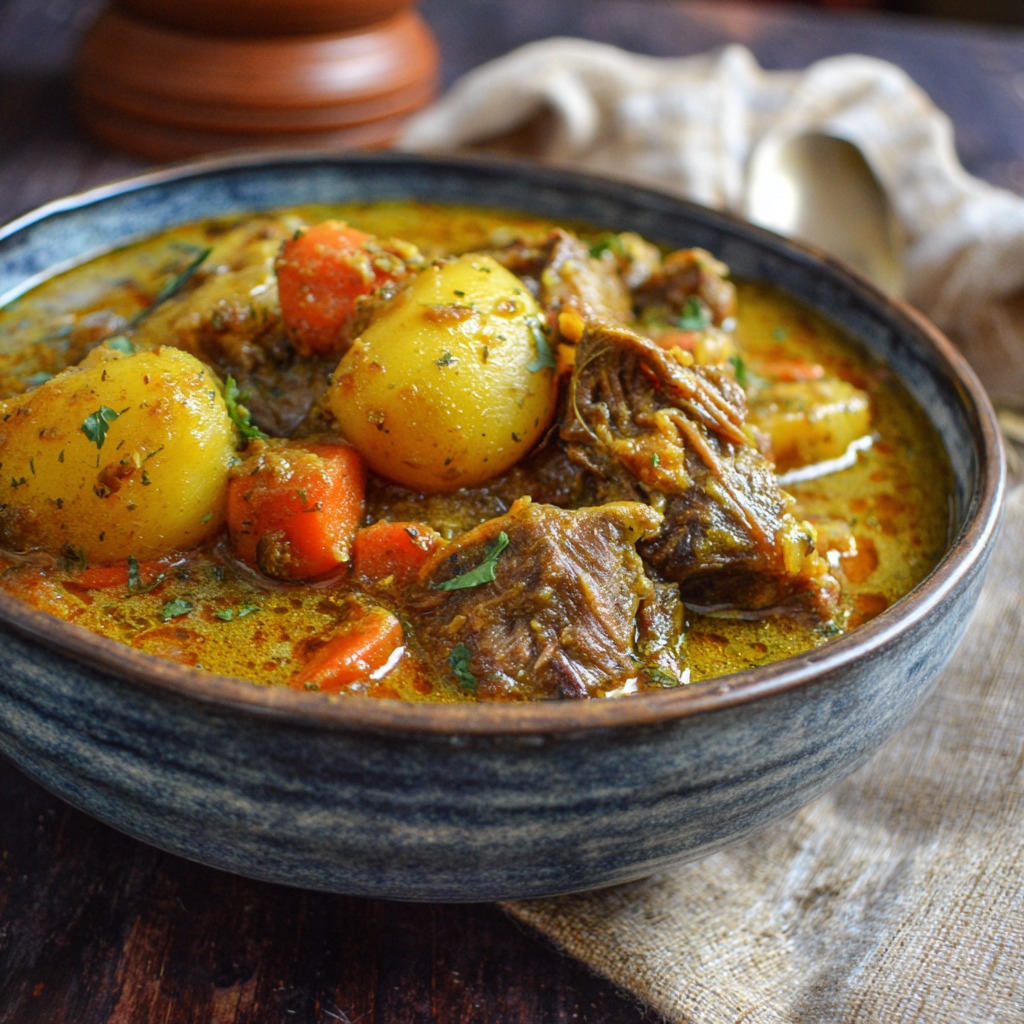
Why You’ll Love This Pastele Stew Recipe
A Taste of Puerto Rican Tradition : This recipe celebrates cultural heritage in a way that’s accessible to everyone, bringing island flavors to your kitchen no matter where you live.
All the Flavor, Less Work : You get the authentic taste of Puerto Rican pasteles without spending hours grating vegetables, wrapping them in banana leaves, and steaming. Everything goes into one pot for an easier, faster cooking process.
Rich, Comforting Flavor : Every spoonful bursts with seasoned meat, sofrito, olives, and root vegetables simmered in a flavorful broth. It’s the kind of comfort food that makes you want seconds.
Perfect for Any Occasion: Whether it’s a holiday gathering, family dinner, or a cozy night in, this dish feels special while still being easy enough for a weeknight.
Customizable : You can use pork, chicken, beef, or even make it vegetarian by swapping the meat for beans or mushrooms, keeping the same delicious base flavors.
Main Highlights
Easier Than Traditional Pasteles – No wrapping or steaming required.
Authentic Puerto Rican Flavor – Captures the taste of traditional pasteles in a convenient stew form.
One-Pot Meal – All ingredients cook together, saving time and reducing cleanup.
Versatile Protein Options – Works with pork, chicken, beef, or vegetarian substitutions.
Hearty & Comforting – Filled with seasoned meat, root vegetables, and aromatic sofrito.
Perfect for Gatherings – Ideal for holidays, potlucks, or weeknight family dinners.
Cost-Saving Benefits
Eliminates the need for costly banana leaves and the extra ingredients required for wrapping traditional pasteles
Uses affordable cuts of meat, such as pork shoulder or chicken thighs, without sacrificing flavor
Incorporates common pantry staples like sofrito, seasonings, and broth, reducing the need for specialty items
Makes a large batch that can be portioned and frozen for future meals, minimizing food waste
Root vegetables and plantains are budget-friendly and add bulk to the stew, stretching your servings
Flavorful Toppings and Customizations
Serve over white rice, yellow rice, or with crusty bread for soaking up the flavorful broth
Fresh chopped cilantro for a burst of herbal brightness
Sliced avocado for creaminess and a mild contrast to the savory stew
A squeeze of fresh lime juice to enhance and balance the flavors
Pickled onions or ají caballero (Puerto Rican hot peppers) for a tangy-spicy kick
Shredded cheese for a rich, melty topping if serving with rice
Extra olives or capers for a briny, salty punch
Drizzle of achiote oil for deeper color and aroma
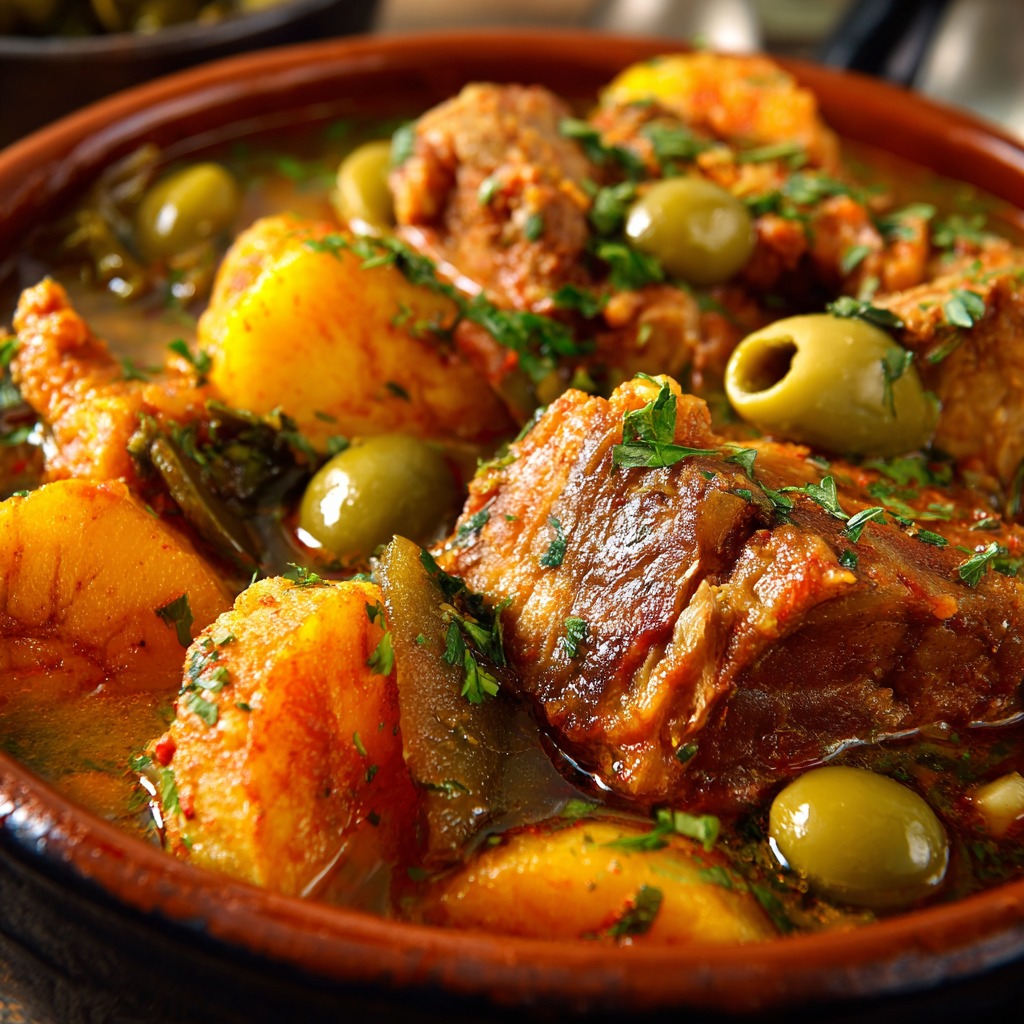
How to Make Pastele Stew Recipe
Quick Overview
The Pastele Stew Recipe is a simplified version of Puerto Rico’s beloved holiday dish, pasteles, transformed into a hearty one-pot meal. Instead of individually wrapping and steaming each pastel, all the signature ingredients, seasoned meat, green bananas, plantains, root vegetables, and aromatic sofrito, are simmered together in a rich, flavorful broth. This method delivers the same comforting taste in far less time.
Perfect for weeknight dinners, potlucks, or festive gatherings, Pastele Stew offers flexibility with protein choices, works well for large batches, and can be customized with toppings like fresh cilantro, avocado, or pickled onions. It’s an easy way to enjoy a taste of Puerto Rican tradition without the labor-intensive process.
Key Ingredients
- Green bananas and plantains (grated or chopped) – these give pasteles their unique texture
- Root vegetables like yautía, yucca, or potatoes for extra heartiness
- Pork shoulder, chicken thighs, or beef, seasoned and cooked in the stew
- Sofrito, a mix of peppers, onions, garlic, and herbs, which forms the flavor base
- Olives and capers to add a salty, briny flavor
- Achiote oil or annatto seeds for color and subtle earthiness
- Garlic, onions, and spices to deepen the taste
- Broth or water to simmer everything into a rich, comforting stew
Let me know if you want me to help with the full recipe instructions!
Ingredient List
Here’s a clear Ingredient List for your Pastele Stew Recipe:
- 3 green bananas, peeled and grated
- 2 plantains, peeled and grated
- 1 cup yautía (or substitute with potatoes or yucca), peeled and grated
- 2 lbs pork shoulder or chicken thighs, cut into bite-sized pieces
- 1 cup sofrito (blend of onions, peppers, garlic, cilantro, and herbs)
- 1/2 cup green olives, sliced
- 2 tablespoons capers
- 2 tablespoons achiote oil (or annatto oil)
- 1 medium onion, chopped
- 4 cloves garlic, minced
- 4 cups chicken broth or water
- 1 teaspoon dried oregano
- 1 teaspoon ground cumin
- Salt and pepper to taste
- Fresh cilantro for garnish (optional)
Step-by-Step Instructions
Prepare the vegetables:
Peel and grate the green bananas, plantains, and yautía (or your chosen root vegetable). Set aside.
Brown the meat:
In a large pot or Dutch oven, heat the achiote oil over medium-high heat. Add the pork shoulder or chicken pieces and brown them on all sides for about 5-7 minutes. Remove and set aside.
Sauté the aromatics:
In the same pot, add the chopped onion and minced garlic. Cook until soft and fragrant, about 3-4 minutes.
Add sofrito and spices:
Stir in the sofrito, oregano, cumin, salt, and pepper. Cook for another 2-3 minutes to let the flavors develop.
Combine ingredients:
Return the browned meat to the pot. Add the grated green bananas, plantains, and yautía. Mix everything well.
Add broth and simmer:
Pour in the chicken broth (or water) until the ingredients are just covered. Stir in the olives and capers. Bring to a boil, then reduce heat to low. Cover and simmer for about 45 minutes to 1 hour, stirring occasionally, until the meat is tender and the vegetables are cooked through.
Adjust seasoning:
Taste the stew and adjust salt and pepper if needed.
Serve:
Ladle the stew into bowls and garnish with fresh cilantro if desired. Enjoy with white rice, crusty bread, or on its own!
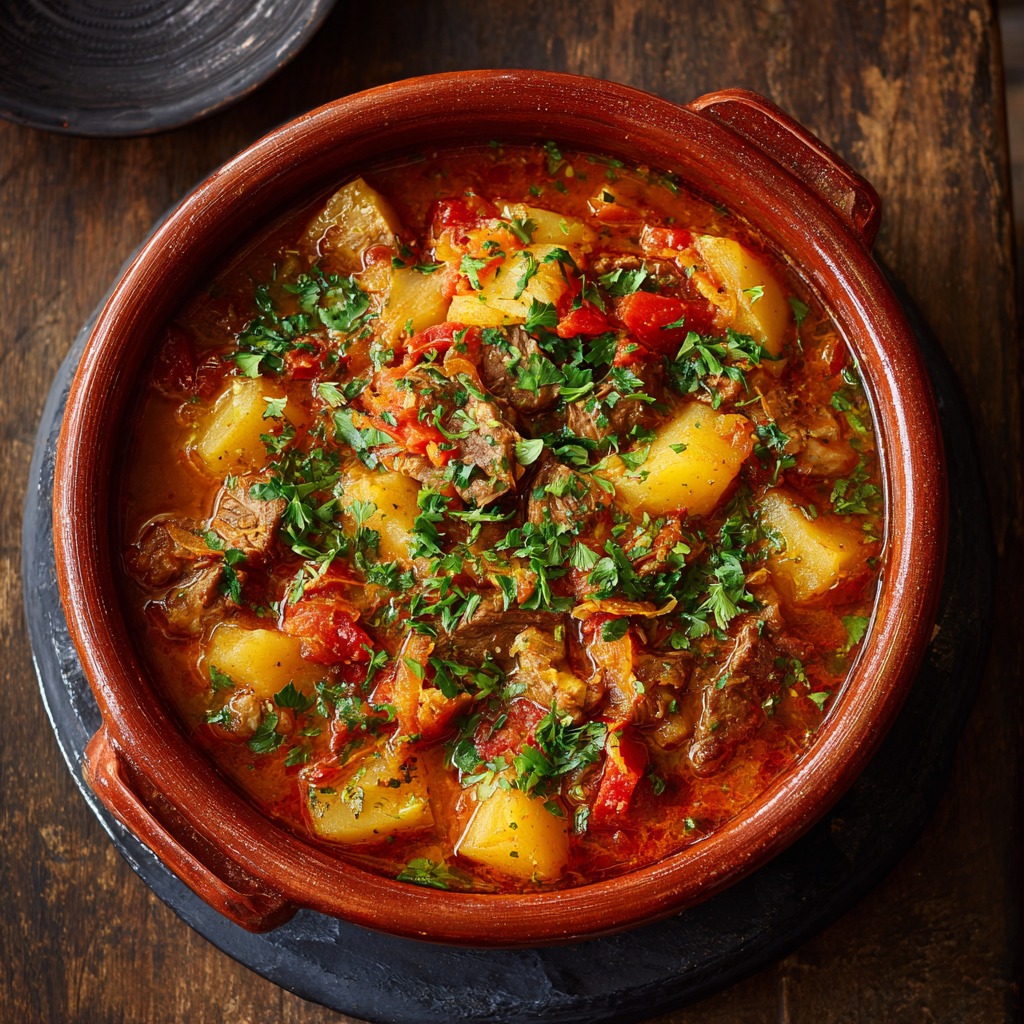
Top Tips for Perfecting Pastele Stew Recipe
Use firm green bananas and plantains: Make sure they’re unripe and firm for the authentic texture and flavor. Overripe ones will make the stew too sweet and mushy.
Grate vegetables finely: This helps the vegetables cook evenly and blend nicely into the stew’s texture.
Don’t skip the sofrito: It’s the flavor base of the dish and adds essential aroma and depth.
Brown the meat well: This step builds rich flavor through caramelization—take your time here.
Simmer gently: Keep the stew at a low simmer to allow flavors to meld and the meat to become tender without drying out.
Adjust seasoning at the end: Always taste before serving and tweak salt, pepper, or acidity to balance the flavors.
Make it ahead: Like many stews, pastele stew tastes even better the next day as the flavors have more time to develop.
Customize toppings: Fresh herbs, a squeeze of lime, or pickled onions can brighten up the dish beautifully.
Ingredient Substitutions for Pastele Stew Recipe
Broth: Use vegetable broth or water if you want a lighter or vegetarian version
Green bananas & plantains: If you can’t find these, use unripe potatoes or a mix of potatoes and green plantains for similar texture.
Yautía (taro root): Substitute with yucca, cassava, or even sweet potatoes for a slightly different but still hearty root vegetable flavor.
Pork shoulder: Chicken thighs, beef chuck, or even turkey work well as alternative proteins.
Sofrito: If you don’t have homemade sofrito, you can use store-bought versions or a mix of finely chopped onions, garlic, bell peppers, and cilantro.
Achiote oil (annatto): Use a bit of paprika or turmeric for color, though the flavor will be milder.
Olives and capers: Green olives can be swapped for black olives or omitted if unavailable; capers can be skipped or replaced with a splash of lemon juice for tanginess.
Timing Adjustments for Pastele Stew Recipe
Freezing:
Pastele stew freezes well. Cool completely, then portion into airtight containers. Thaw in the fridge overnight before reheating slowly on the stove.
If you’re short on time:
Use smaller pieces of meat to speed up cooking. You can also cut down the simmering time to 30-40 minutes, but make sure the meat is cooked through and tender.
For richer flavor:
Let the stew simmer longer, up to 1.5 hours, on low heat. This allows flavors to deepen and the meat to become very tender.
Make ahead:
Prepare the stew a day or two in advance. Refrigerate overnight to let the flavors meld, then gently reheat before serving.
Common Mistakes to Avoid When Making Pastele Stew
Ignoring sofrito: It’s key for authentic flavor,don’t substitute it with plain onions or garlic alone.
Using ripe bananas or plantains: This makes the stew too sweet and mushy. Always choose firm, green ones.
Skipping browning the meat: Browning adds depth and richness—don’t rush this step.
Not cooking long enough: Undercooked meat or vegetables can make the stew tough or gritty. Make sure to simmer until everything is tender.
Overcrowding the pot: Adding too many ingredients at once can lower the temperature and prevent proper browning and cooking. Cook in batches if needed.
Forgetting to taste and adjust seasoning: Always taste the stew near the end and tweak salt, pepper, or acidity to balance flavors.
Using too much liquid: The stew should be thick and hearty, not watery. Add broth gradually and watch the consistency.
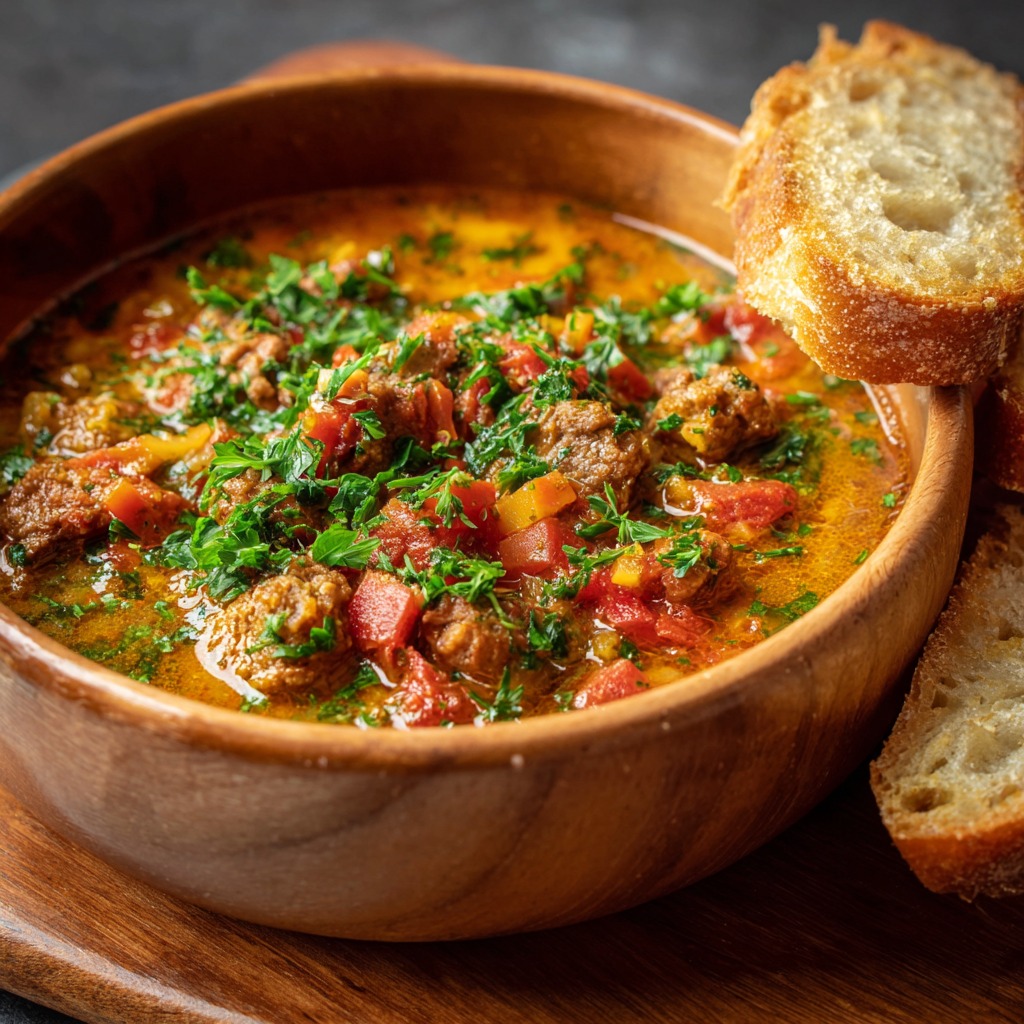
Storing and Reheating Tips Pastele Stew Recipe
- Storage: Let the stew cool completely before transferring it to airtight containers. It keeps well in the refrigerator for up to 4 days.
- Freezing: Pastele stew freezes beautifully. Portion it into freezer-safe containers or heavy-duty zip-top bags and freeze for up to 3 months.
- Thawing: For best results, thaw frozen stew overnight in the refrigerator before reheating.
- Reheating: Warm the stew gently on the stovetop over low to medium heat, stirring occasionally. Add a splash of broth or water if it seems too thick.
- Avoid microwaving straight from frozen: This can cause uneven heating and affect the texture.
Following these tips will help you enjoy your Pastele Stew fresh and delicious even days after cooking!
Health Benefits of Pastele Stew Recipe
Health Benefits of Pastele Stew
| Benefit | Explanation |
|---|---|
| Rich in Fiber | Contains green bananas, plantains, and root vegetables that support digestion. |
| Good Source of Protein | Includes pork, chicken, or beef, which provide essential amino acids for muscle repair and growth. |
| Packed with Vitamins & Minerals | Vegetables and sofrito add vitamins A, C, potassium, and antioxidants. |
| Balanced Carbohydrates | The combination of starchy vegetables offers sustained energy release. |
| Low in Added Sugars | Naturally savory with no added sugars, making it a wholesome meal choice. |
| Supports Immune Health | Garlic, onions, and herbs in sofrito contain compounds that boost immunity. |
If you want, I can help expand this table or format it for a specific use like a blog or printable handout!
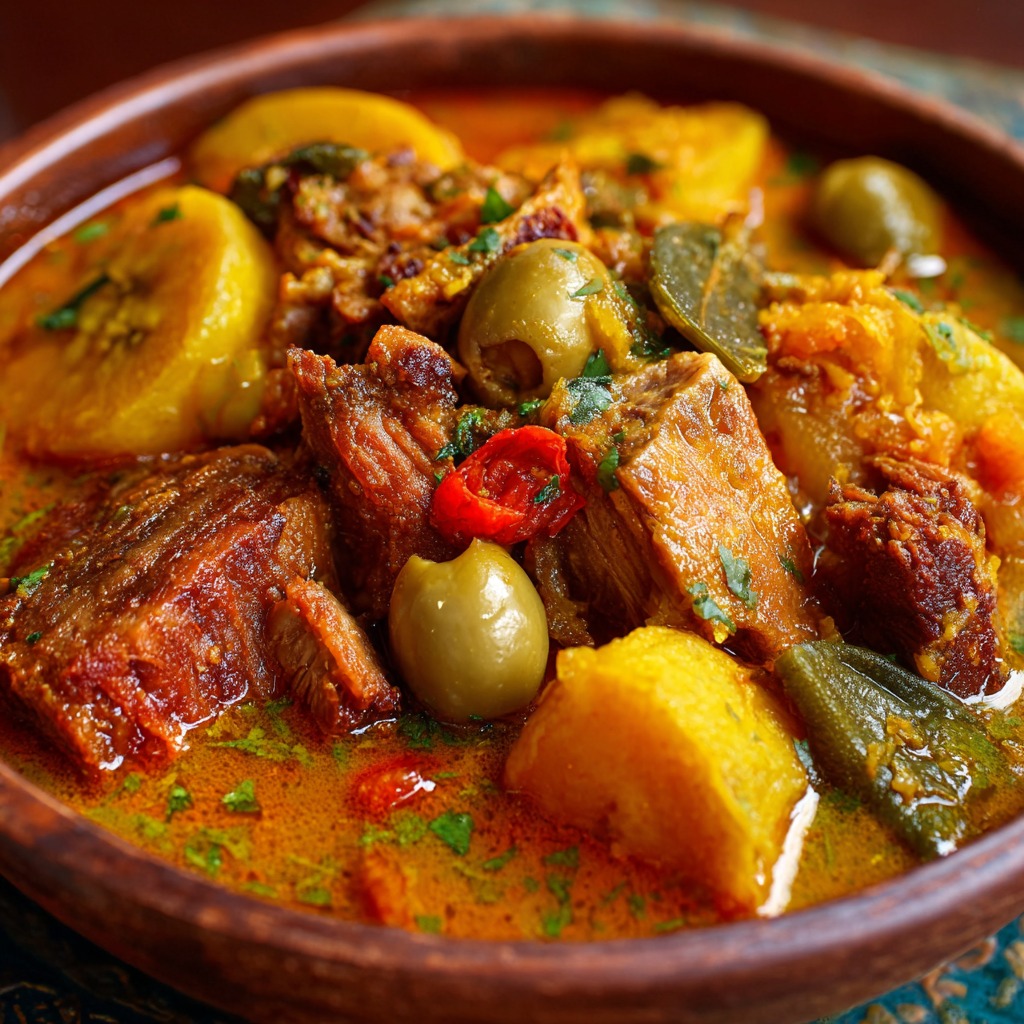
Why These Ingredients Are Good for You
Here’s a clear explanation of Why These Ingredients Are Good for You in the Pastele Stew Recipe:
- Green Bananas and Plantains: High in dietary fiber and resistant starch, they support healthy digestion and help maintain steady blood sugar levels.
- Root Vegetables (like yautía, yucca): Rich in vitamins, minerals, and fiber, they provide sustained energy and promote gut health.
- Pork, Chicken, or Beef: Excellent sources of complete protein, essential for muscle repair, immune function, and overall body strength.
- Sofrito (onions, garlic, peppers, herbs): Packed with antioxidants and anti-inflammatory compounds, these ingredients boost the immune system and add flavor without extra calories.
- Olives and Capers: Contain healthy fats and antioxidants, which support heart health and reduce inflammation.
- Achiote Oil: Provides antioxidants and adds beneficial compounds that can aid in reducing oxidative stress.
Together, these ingredients make Pastele Stew not only delicious but also nourishing and wholesome.
Pastele Stew Recipe From DishBloom!
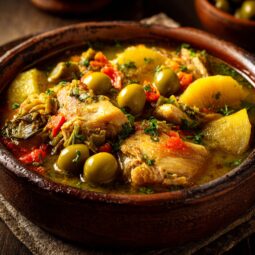
Pastele Stew Recipe
Equipment
- Large pot or Dutch oven
- Grater or food processor (for vegetables)
- Knife and cutting board
- Stirring Spoon
Ingredients
- 3 green bananas peeled and grated
- 2 plantains peeled and grated
- 1 cup yautía or substitute with potatoes or yucca, peeled and grated
- 2 lbs pork shoulder or chicken thighs cut into bite-sized pieces
- 1 cup sofrito
- 1/2 cup green olives sliced
- 2 tablespoons capers
- 2 tablespoons achiote oil
- 1 medium onion chopped
- 4 cloves garlic minced
- 4 cups chicken broth or water
- 1 teaspoon dried oregano
- 1 teaspoon ground cumin
- Salt and pepper to taste
- Fresh cilantro for garnish optional
Instructions
- Peel and grate the green bananas, plantains, and yautía. Set aside.
- Heat achiote oil in a large pot over medium-high heat. Brown the meat on all sides (5-7 minutes). Remove and set aside.
- In the same pot, sauté onion and garlic until soft (3-4 minutes).
- Add sofrito, oregano, cumin, salt, and pepper. Cook 2-3 minutes.
- Return meat to the pot. Add grated vegetables and mix well.
- Pour in broth until ingredients are just covered. Stir in olives and capers. Bring to boil, then reduce heat to low. Cover and simmer 45 minutes to 1 hour until meat is tender.
- Taste and adjust seasoning.
- Serve garnished with fresh cilantro if desired.

Notes
- Use firm green bananas and plantains for the best texture.
- Sofrito is key to authentic flavor—homemade or store-bought works well.
- This stew tastes even better the next day!
- Freeze leftovers in portioned containers for up to 3 months.
- Customize with toppings like avocado, lime juice, or pickled onions.

Conclusion
The Pastele Stew Recipe is a delicious and convenient way to enjoy the rich, comforting flavors of traditional Puerto Rican pasteles without the lengthy preparation. This one-pot meal combines hearty root vegetables, seasoned meat, and vibrant sofrito into a stew that’s perfect for family dinners, holidays, or any occasion that calls for warmth and flavor.
With its cost-saving benefits, customizable options, and satisfying taste, this stew brings a taste of Puerto Rican culture right to your table. Whether you’re making it for the first time or adding it to your recipe rotation, Pastele Stew is sure to become a beloved favorite.
Give it a try and savor the vibrant flavors and comforting warmth of this unique and hearty dish!
Share Your Twist!
Have you tried this Pastele Stew Recipe with your own personal touch? Maybe you added a unique spice, swapped proteins, or topped it with something unexpected!
I’d love to hear how you made it your own, drop your favorite twists, tips, or serving ideas. Sharing your version can inspire others to enjoy this delicious Puerto Rican classic in new and exciting ways!
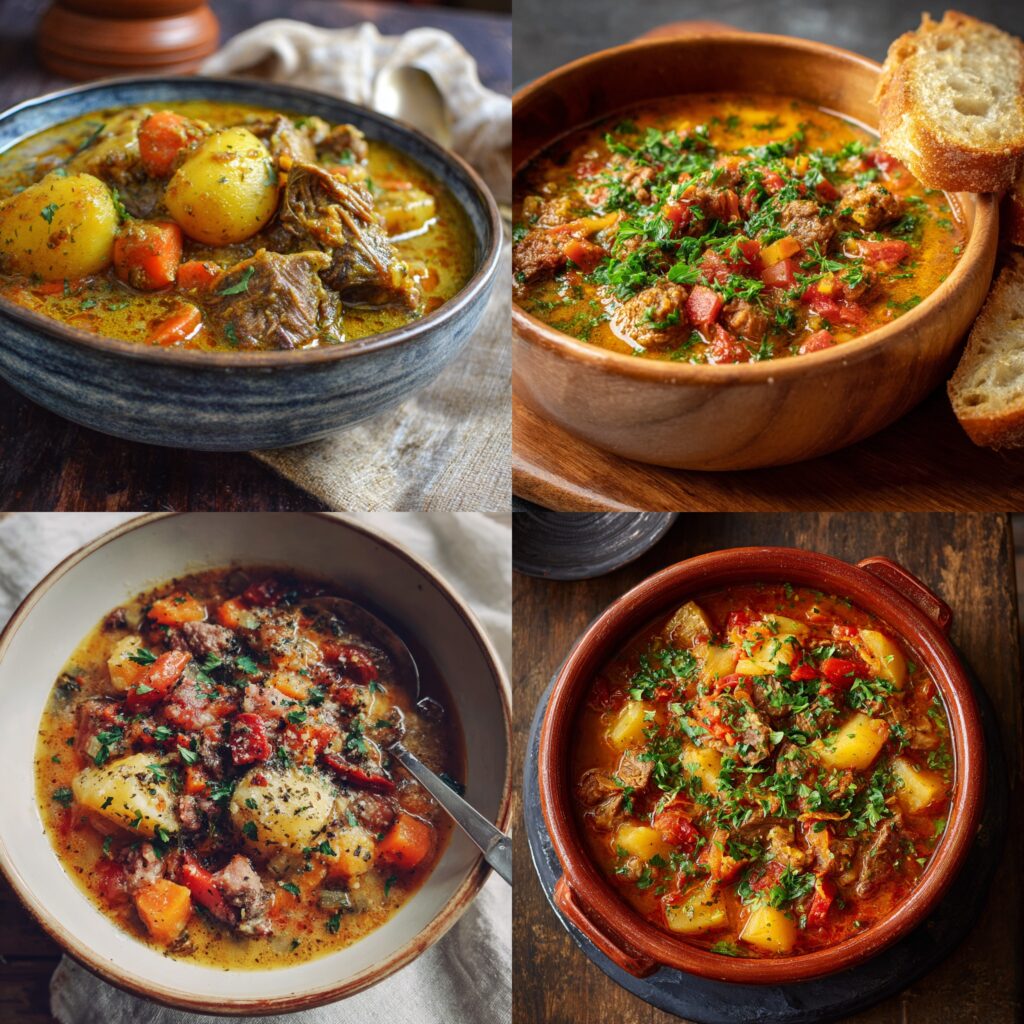
FAQs: Pastele Stew Recipe
Frequently Asked Questions (FAQs)
What is Pastele Stew?
Pastele Stew is a traditional Puerto Rican dish inspired by pasteles, made with green bananas, plantains, root vegetables, seasoned meat, and a flavorful sofrito base.
Can I substitute the yautía with other vegetables?
Yes, you can substitute yautía with yucca, cassava, or potatoes if those are easier to find.
Is Pastele Stew gluten-free?
Yes, this recipe is naturally gluten-free as it uses whole vegetables and meats without any wheat-based ingredients.

